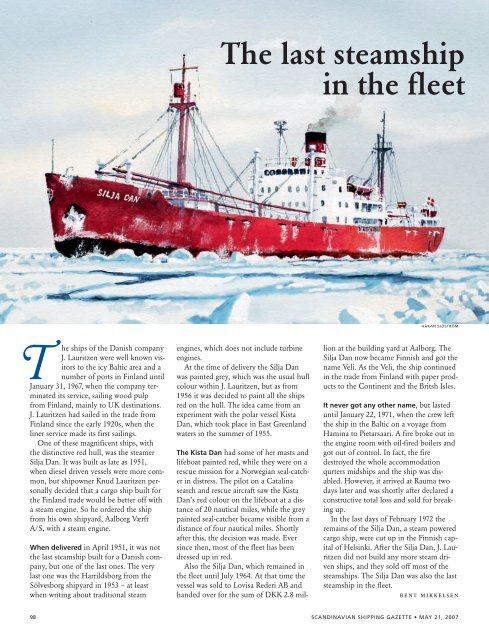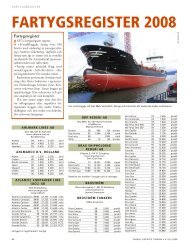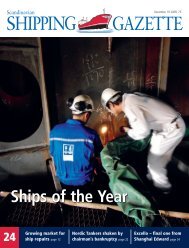SSG No 10 - Shipgaz
SSG No 10 - Shipgaz
SSG No 10 - Shipgaz
You also want an ePaper? Increase the reach of your titles
YUMPU automatically turns print PDFs into web optimized ePapers that Google loves.
T<br />
he ships of the Danish company<br />
J. Lauritzen were well known visitors<br />
to the icy Baltic area and a<br />
number of ports in Finland until<br />
January 31, 1967, when the company terminated<br />
its service, sailing wood pulp<br />
from Finland, mainly to UK destinations.<br />
J. Lauritzen had sailed in the trade from<br />
Finland since the early 1920s, when the<br />
liner service made its first sailings.<br />
One of these magnificent ships, with<br />
the distinctive red hull, was the steamer<br />
Silja Dan. It was built as late as 1951,<br />
when diesel driven vessels were more common,<br />
but shipowner Knud Lauritzen personally<br />
decided that a cargo ship built for<br />
the Finland trade would be better off with<br />
a steam engine. So he ordered the ship<br />
from his own shipyard, Aalborg Værft<br />
A/S, with a steam engine.<br />
When delivered in April 1951, it was not<br />
the last steamship built for a Danish company,<br />
but one of the last ones. The very<br />
last one was the Harrildsborg from the<br />
Sölvesborg shipyard in 1953 – at least<br />
when writing about traditional steam<br />
The last steamship<br />
in the fleet<br />
engines, which does not include turbine<br />
engines.<br />
At the time of delivery the Silja Dan<br />
was painted grey, which was the usual hull<br />
colour within J. Lauritzen, but as from<br />
1956 it was decided to paint all the ships<br />
red on the hull. The idea came from an<br />
experiment with the polar vessel Kista<br />
Dan, which took place in East Greenland<br />
waters in the summer of 1955.<br />
The Kista Dan had some of her masts and<br />
lifeboat painted red, while they were on a<br />
rescue mission for a <strong>No</strong>rwegian seal-catcher<br />
in distress. The pilot on a Catalina<br />
search and rescue aircraft saw the Kista<br />
Dan’s red colour on the lifeboat at a distance<br />
of 20 nautical miles, while the grey<br />
painted seal-catcher became visible from a<br />
distance of four nautical miles. Shortly<br />
after this, the decision was made. Ever<br />
since then, most of the fleet has been<br />
dressed up in red.<br />
Also the Silja Dan, which remained in<br />
the fleet until July 1964. At that time the<br />
vessel was sold to Lovisa Rederi AB and<br />
handed over for the sum of DKK 2.8 mil-<br />
HÅKAN SJÖSTRÖM<br />
lion at the building yard at Aalborg. The<br />
Silja Dan now became Finnish and got the<br />
name Veli. As the Veli, the ship continued<br />
in the trade from Finland with paper products<br />
to the Continent and the Britsh Isles.<br />
It never got any other name, but lasted<br />
until January 22, 1971, when the crew left<br />
the ship in the Baltic on a voyage from<br />
Hamina to Pietarsaari. A fire broke out in<br />
the engine room with oil-fired boilers and<br />
got out of control. In fact, the fire<br />
destroyed the whole accommodation<br />
qurters midships and the ship was disabled.<br />
However, it arrived at Rauma two<br />
days later and was shortly after declared a<br />
constructive total loss and sold for breaking<br />
up.<br />
In the last days of February 1972 the<br />
remains of the Silja Dan, a steam powered<br />
cargo ship, were cut up in the Finnish capital<br />
of Helsinki. After the Silja Dan, J. Lauritzen<br />
did not build any more steam driven<br />
ships, and they sold off most of the<br />
steamships. The Silja Dan was also the last<br />
steamship in the fleet.<br />
bent mikkelsen<br />
98 SCANDINAVIAN SHIPPING GAZETTE • MAY 21, 2007













